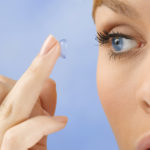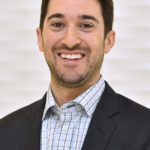By Mark Schaeffer, OD
Dec. 29, 2021
Your contact lens patients bring more money into your practice than glasses-only patients, purchasing both contact lenses and eyewear. They also are more likely to come every year on time for a comprehensive exam, so they can get their contact lens prescription renewed and purchase materials.
Here are the key steps I take to ensure my contact lens patients stay in their lenses as long as they want to, so happier patients and a more profitable practice are created.
Better Patient Care, Greater Profitability By Keeping Patients in CLs
Contact lens patients are more compliant on their recall schedule, which means more office visits to your practice. Without revenue coming into the practice, there can be no profitability. Contact lens wearers spend more in your practice (in all practices) over a lifetime than glasses-only wearers. Remember, these patients also need to have backup glasses. But they do spend more on materials and services over a lifetime even factoring out the contact lens material purchase.i
Because there is a need to treat the ocular surface for most of these patients, you’ll see these patients back to manage therapies. More office visits into the clinic with medical insurance, as you diagnose more patients with ocular surface disease, increases your revenue to the practice. The therapies you prescribe (i.e. supplementation/nutraceuticals, in-office procedures, at-home therapies, OTC drops sold) will also bring in revenue to the practice.ii
4 Initial Steps to Take With Each Patient
1. Surveys and entrance questionnaires. I use the SPEED (Standard Patient Evaluation of Eye Dryness) for all patients, but I epecially like it for contact lens wearers. There is some crossover between this and the CLDEQ-8 (Contact Lens Dry Eye Questionnaire), and some studies that show both/either work to demonstrate patient complaints. I like SPEED because it is one survey I can use for all patients. Anyone who scores over a 6 warrants a discussion about their ocular surface health.
2. Assessment of anterior surface. We do this for all patients who come in the door. We are looking specifically at blepharitis, changes in meibomian gland structure and function and corneal/conjunctival irregularity. Any signs or early changes to these structures can affect contact lens comfort, vision and overall experience. As part of our contact lens evaluation, we pay extra attention to these areas to make sure the surface is optimized for successful contact lens wear.
3. Discussion of current technologies in contact lenses using lifestyle questions with the patient. There has been an explosion of contact lens innovations to help increase wear time and decrease contact lens-associated dryness. This is markedly different, but also similar to ocular surface disease, also known as dry eye disease. Figuring out if the patient needs a new lens, better tear mechanics, or both, requires asking the right questions.
4. Return for further testing. Sometimes the contact lens evaluation is delayed to get a true sense of the ocular surface. Is there short-term contact lens-related inflammation, or is there a more chronic aspect to the disease? Typically the answer is both, but getting inflammation in check leads to better outcomes for both vision and comfort. Imaging the ocular surface, getting osmolarity and checking for inflammatory markers gives us a better understanding of the nature of the underlying disease.
Clean Up Ocular Surface
I like to start by treating inside out. I think most of our contact lens wearers have altered meibomian gland structure and function. A study confirms that even people who only wore lenses for six months had altered gland morphology versus people who did not wear contact lenses. By helping the oil layer retain more tears on the surface, lenses are less likely to dry out, vision is more stable and patients are happier. I use HydroEye by ScienceBased Health, but there are many great supplements to help with meibomian gland dysfunction.
In-office procedures like LipiFlow have been shown to increase comfortable contact lens wear by four hours in some patients. Other procedures like TearCare and Intense Pulse Light (IPL) therapy have been shown to be effective at reducing signs and symptoms of ocular surface disease that affects contact lens wear.
Don’t forget to look at the lashes as well. Demodex and other forms of blepharitis can cause issues with the ocular surface that can affect contact lens wear. Cleaning up the lash line with microblepharoexfoliation or other at-home treatments are effective.
However, sometimes patients also need to make better tears that stay on the eye longer. For more advanced cases, I like to start with a steroid like EYsuVIS, which is FDA-approved for signs and symptoms of dry eye to calm the ocular surface, but other steroids can be used to treat the inflammation, like Lotemax and Flarex. Once cleared, I’ll use a longer-term therapy like Restasis, Xiidra, or Cequa, to create a better environment for the lenses to perform.
Other Articles to Explore
Upgrade Patient Into CL with Newer Technology
Once we’ve gotten the surface cleaned up, I try to upgrade the patient into one of the newer technologies designed to help with end-of-day contact lens-associated dryness. In the daily disposables category there are several new lenses that patients are excited about when they have them on the eye:
Bausch + Lomb INFUSE One-Day Contact Lenses, which takes the TFOS DEWS II report and uses its recommendations to build a lens designed to promote ocular surface homeostasis.
Precision1 One-Day Contact Lenses and Dailies Total1 Contact Lenses from Alcon, which use water surface technology to create a cushion of moisture at the surface to help with lens comfort, vision and handling.
MyDay by CooperVision with its Smart Silicone technology to increase water content while remaining high oxygen transmissibility.
ACUVUE OASYS 1-Day Contact Lenses with HydraLuxe that mimics the tears for all-day comfort.
In addition to those daily disposable options, Alcon recently launched a new monthly lens, Total30, featuring a similar water gradient technology to that used in Dailies Total1 applied to a monthly lens. It has a different design with similar features to hold up to the rigors of monthly wear, but achieves the same end result: happy patients on day one and day 30.
Bottom Line: Listen to Patients & Respond
The actions I take with each patient to ensure comfort and continued contact lens wear may seem confusing or complex, but it’s simple.
If the patient is experiencing contact lens discomfort, from fluctuating vision to ocular discomfort, examine the ocular surface and provide treatment for underlying issues like dry eye.
Next, educate patients about the value of upgrading into contact lenses made with more advanced technology.
Small changes can lead to huge gains in a patient’s contact lens wearing experience. Listening and responding to those complaints, or early warning signs, will elevate patient care and your practice income. There is no downside to treating medical issues and giving patients better care.
References
i. https://pubmed.ncbi.nlm.nih.gov/23458980/
 Mark Schaeffer, OD, is Clinical Field Manager and optometrist at MyEyeDr. in Birmingham, Ala. He is a founding member of the Intrepid Eye Society. To contact him: mark@drmesconsulting.com
Mark Schaeffer, OD, is Clinical Field Manager and optometrist at MyEyeDr. in Birmingham, Ala. He is a founding member of the Intrepid Eye Society. To contact him: mark@drmesconsulting.com

























